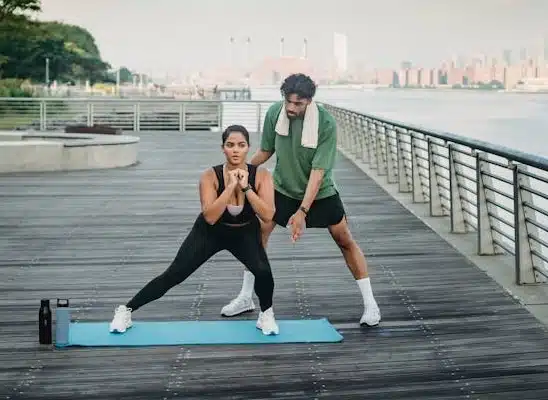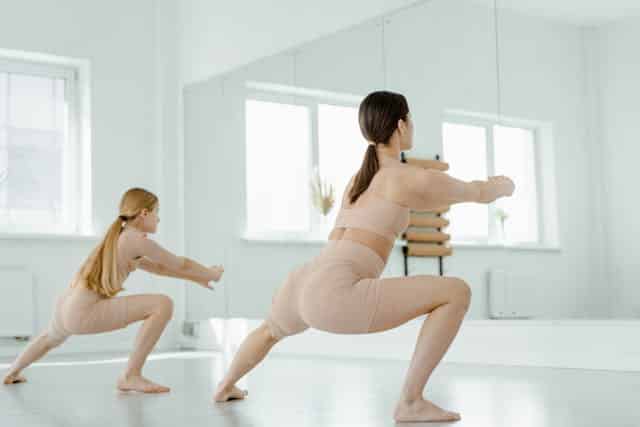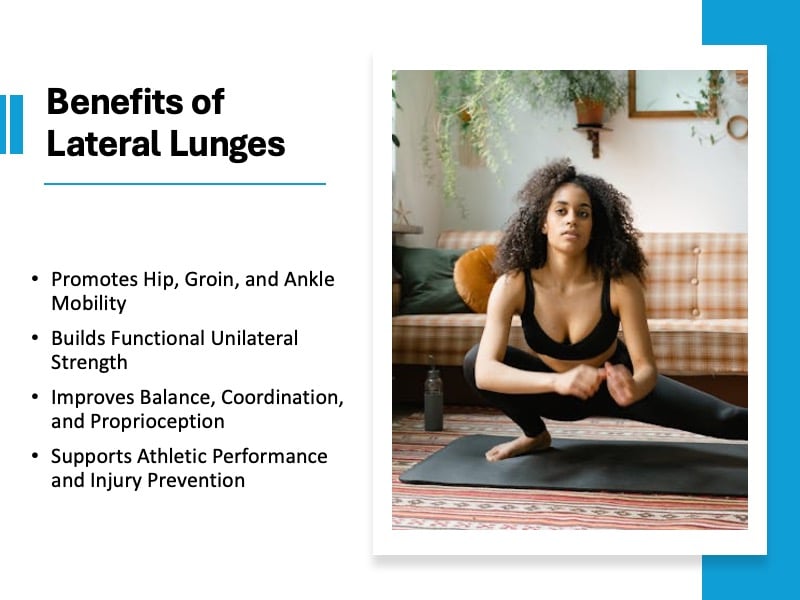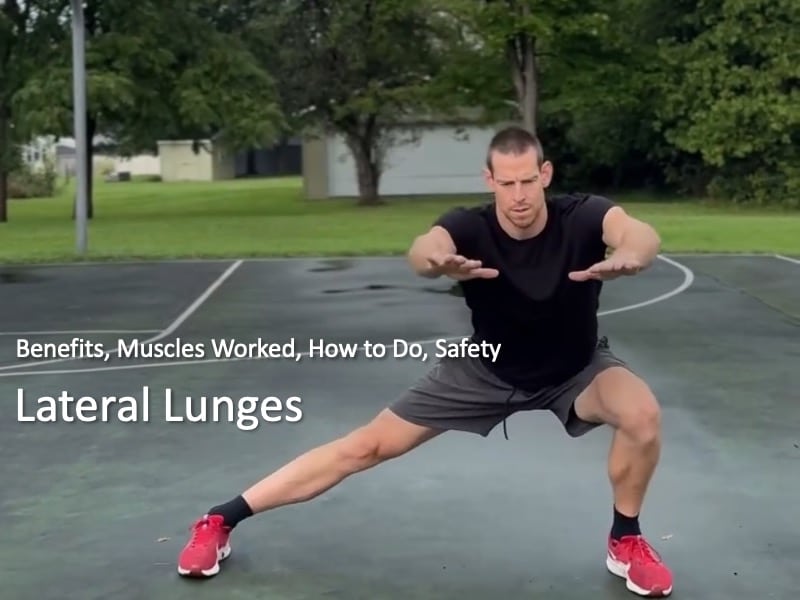Lateral Lunges: Benefits, Muscles Worked, How to Do, Safety
Lateral lunges are one of the most effective and underrated exercises for building strength, balance, and mobility in the hips and lower body.
Unlike traditional squats and lunges that focus on forward or vertical movement, the lateral lunge exercise challenges your muscles in a side-to-side plane, helping create more well-rounded, resilient movement patterns.
Lateral lunges improve hip, groin, and ankle mobility, strengthen unilateral (single-leg) stability, and mimic natural side-to-side movements, which are critical for athletic performance and injury prevention.
Whether you’re a competitive athlete, general fitness enthusiast, or simply aiming to move better in daily life, learning how to do a lateral lunge properly can dramatically upgrade your mobility, strength, and functional fitness.
Here’s everything you need to know about lateral lunges, including their benefits, muscles worked, common mistakes, and how to add them to your workout routine for best results!
What is a Lateral Lunge?

For those wondering what is a lateral lunge, it is a dynamic strength exercise where you step out to the side, bend one knee to lower into a lunge, while keeping the other leg extended straight.
A lateral lunge, sometimes called a side lunge, is a lower-body exercise where you take a wide step to the side, bend one knee deeply, and keep the opposite leg extended, then push off to return to the starting position.
The distinguishing factor is that the lateral lunge exercise emphasizes lateral (side-to-side) motion rather than the traditional forward lunge or squat patterns.
Proper lateral lunge form requires keeping the chest tall, the working foot flat on the ground, and the extended leg straight without collapsing the torso forward.
By strengthening muscles and connective tissues in this often-neglected plane of motion, the lateral lunge helps improve overall stability, athleticism, and injury resilience.
Lateral Lunges Muscles Worked

The lateral lunge is a multi-joint, compound movement that targets several key muscle groups across the lower body and core.
By training these muscles together, the lateral lunge not only builds strength but also improves neuromuscular coordination across the entire lower kinetic chain.
- Quadriceps: As you bend your working leg, the quadriceps control knee flexion and extension.
- Gluteus Maximus and Medius: Power the push-off phase and stabilize the hips.
- Adductors (Inner Thighs): Help decelerate and control the leg during the descent and stabilize during the push-off.
- Hamstrings: Assist in controlling the movement during the descent and supporting knee and hip stability.
- Calves: Provide ankle stability throughout the movement.
- Core Muscles: Engage to maintain balance and a tall, upright posture.
How to Do Lateral Lunges
Mastering lateral lunge technique is essential for maximizing its benefits and minimizing the risk of injury.
Follow these simple steps for proper form:
- Stand tall with your feet hip-width apart, core engaged, and hands on your hips or in front of your chest for balance.
- Step out to the side with your right leg, keeping your left leg straight.
- Bend your right knee and push your hips back as if sitting into a chair, lowering until your thigh is roughly parallel to the ground.
- Keep your chest upright and your weight distributed on your heel, ensuring your right knee stays aligned over your toes.
- Push off your right foot to return to the starting position.
- Repeat on the left side.
Move with control rather than momentum, focusing on activating the glutes, hamstrings, and inner thighs as you shift side to side.
Benefits of Lateral Lunges

Incorporating lateral lunges into your routine offers a range of powerful benefits that traditional sagittal-plane exercises (like squats and forward lunges) often miss.
Even better, you don’t need any equipment to start seeing results.
Lateral lunges are one of the best bodyweight leg exercises since most people rarely train these muscle groups in a lateral plane of motion, and your bodyweight alone is enough to build strength, improve mobility, and correct imbalances.
Promotes Hip, Groin, and Ankle Mobility
The lateral lunge dynamically stretches and strengthens the adductors, hip flexors, hamstrings, and ankles, which are crucial for fluid side-to-side movement and injury prevention (Behm & Chaouachi, 2011).
Builds Functional Unilateral Strength
Training one leg at a time helps correct muscle imbalances between limbs, which is important for sports performance and overall joint health.
The lateral lunge specifically targets muscles on the outside and inside of the hips, providing a balance that forward-focused exercises often lack.
Improves Balance, Coordination, and Proprioception
Stepping out and stabilizing through one side challenges your proprioceptive system (the body’s ability to sense position, movement, and stability), leading to better overall balance and athletic performance.
Supports Athletic Performance and Injury Prevention
Sports like basketball, soccer, tennis, and skiing involve rapid side-to-side motions.
Training with lateral lunges builds strength and control in these patterns, potentially reducing the risk of groin strains, ACL injuries, and ankle sprains (Short et al., 2021).
From my experience as a professional basketball player, lateral lunges and their variations are definitely one of the best exercises for basketball players. It’s combination of strength and mobility is perfect for preventing injuries and developing functional strength for sports.
Safety Tips for the Lateral Lunge
While the lateral lunge is highly beneficial, proper technique is crucial to ensure safety and effectiveness.
- Warm Up Thoroughly: Before lateral lunges, perform dynamic stretches focusing on the hips, hamstrings, and ankles.
- Prioritize Controlled Movement: Avoid rushing or “dropping” into the lunge. Slow, controlled lowering ensures better muscle activation and reduces joint stress.
- Focus on Knee Alignment: Make sure the working knee stays over the toes and doesn’t collapse inward, which can strain the knee joint.
- Start Shallow: If flexibility or balance is limited, begin with smaller steps and partial lunges, gradually increasing depth over time.
- Use Assistance if Needed: When learning the movement, hold onto a TRX strap, wall, or resistance band for support.
How to Add the Lateral Lunge to Your Workout Routine
Adding the lateral lunge strategically to your training can unlock new levels of strength, mobility, and athleticism.
But remember, consistency matters. Integrating lateral lunges 2–3 times per week can significantly enhance lower-body control, hip flexibility, and side-to-side movement power.
During Warm-Ups
Use lateral lunges as a dynamic warm-up exercise to activate muscles, open up the hips, and prepare for more intense strength training.
Strength Training Workouts
Include lateral lunges as an accessory movement after squats, deadlifts, or other major compound exercises. Perform 3–4 sets of 8–12 reps per side.
Mobility Circuits
Combine lateral lunges with exercises like hip airplanes, Cossack squats, or side planks for a complete functional mobility routine.
Progressions
Add dumbbells, kettlebells, or a barbell in a goblet position to increase resistance and challenge the core and legs even more.
Lateral Lunge vs. Cossack Squat: Which is Better?
While the lateral lunge and Cossack squat both target side-to-side strength and mobility, they have distinct focuses.
However, both are valuable and can be combined for comprehensive functional training.
| Feature | Lateral Lunge | Cossack Squat |
|---|---|---|
| Movement Type | Step out to side, return to center | Static deep squat over one leg |
| Focus | Dynamic strength and power | Deep mobility and flexibility |
| Leg Position | Both feet flat, less extreme ROM | One leg fully extended with toes up |
| Mobility Requirement | Moderate | High |
| Best For | Athletic power, side-to-side strength | Deep hip, ankle, and groin mobility |
Final Thoughts: Is the Lateral Lunge a Good Exercise?
The lateral lunge is a simple yet incredibly powerful single-leg exercise for building lower-body strength, mobility, and resilience.
By moving laterally, this lunge variation fills a crucial gap in many training programs that focus only on forward or vertical movement patterns, offering benefits that translate directly to sports performance, injury prevention, and everyday functional movement.
Research consistently shows that incorporating lateral and multidirectional exercises enhances lower-limb stability, neuromuscular control, and dynamic balance, especially in active populations.
If you’re serious about optimizing your strength, balance, and long-term joint health, the lateral lunge deserves a permanent place in your training routine.



